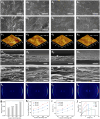Highly Thermoconductive, Strong Graphene-Based Composite Films by Eliminating Nanosheets Wrinkles
- PMID: 37975956
- PMCID: PMC10656391
- DOI: 10.1007/s40820-023-01252-w
Highly Thermoconductive, Strong Graphene-Based Composite Films by Eliminating Nanosheets Wrinkles
Abstract
Graphene-based thermally conductive composites have been proposed as effective thermal management materials for cooling high-power electronic devices. However, when flexible graphene nanosheets are assembled into macroscopic thermally conductive composites, capillary forces induce shrinkage of graphene nanosheets to form wrinkles during solution-based spontaneous drying, which greatly reduces the thermal conductivity of the composites. Herein, graphene nanosheets/aramid nanofiber (GNS/ANF) composite films with high thermal conductivity were prepared by in-plane stretching of GNS/ANF composite hydrogel networks with hydrogen bonds and π-π interactions. The in-plane mechanical stretching eliminates graphene nanosheets wrinkles by suppressing inward shrinkage due to capillary forces during drying and achieves a high in-plane orientation of graphene nanosheets, thereby creating a fast in-plane heat transfer channel. The composite films (GNS/ANF-60 wt%) with eliminated graphene nanosheets wrinkles showed a significant increase in thermal conductivity (146 W m-1 K-1) and tensile strength (207 MPa). The combination of these excellent properties enables the GNS/ANF composite films to be effectively used for cooling flexible LED chips and smartphones, showing promising applications in the thermal management of high-power electronic devices.
Keywords: Aramid nanofiber; Graphene; In-plane stretching; Thermal conductivity; Wrinkles elimination.
© 2023. The Author(s).
Conflict of interest statement
The authors declare no interest conflict. They have no known competing financial interests or personal relationships that could have appeared to influence the work reported in this paper.
Figures





References
-
- From chip to the cooling system, A. Habibi Khalaj, S.K. Halgamuge, A review on efficient thermal management of air- and liquid-cooled data centers. Appl. Energy 205, 1165–1188 (2017). 10.1016/j.apenergy.2017.08.037
-
- N.A. Kyeremateng, T. Brousse, D. Pech, Microsupercapacitors as miniaturized energy-storage components for on-chip electronics. Nat. Nanotechnol. 12(1), 7–15 (2017). 10.1038/nnano.2016.196 - PubMed
-
- C. Woodcock, C. Ng’oma, M. Sweet, Y. Wang, Y. Peles et al., Ultra-high heat flux dissipation with piranha pin fins. Int. J. Heat Mass Transfer 128, 504–515 (2019). 10.1016/j.ijheatmasstransfer.2018.09.030
-
- M. Manno, B. Yang, S. Khanna, P. McCluskey, A. Bar-Cohen, Microcontact-enhanced thermoelectric cooling of ultrahigh heat flux hotspots. IEEE Trans. Compon. Packag. Manuf. Technol. 5(12), 1775–1783 (2015). 10.1109/tcpmt.2015.2495350
-
- H. Song, J. Liu, B. Liu, J. Wu, H.-M. Cheng et al., Two-dimensional materials for thermal management applications. Joule 2(3), 442–463 (2018). 10.1016/j.joule.2018.01.006
LinkOut - more resources
Full Text Sources
Research Materials
Miscellaneous
